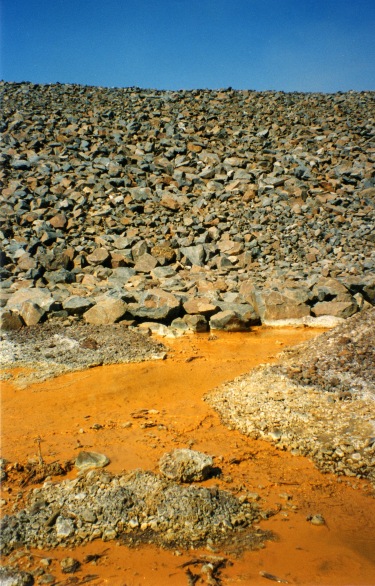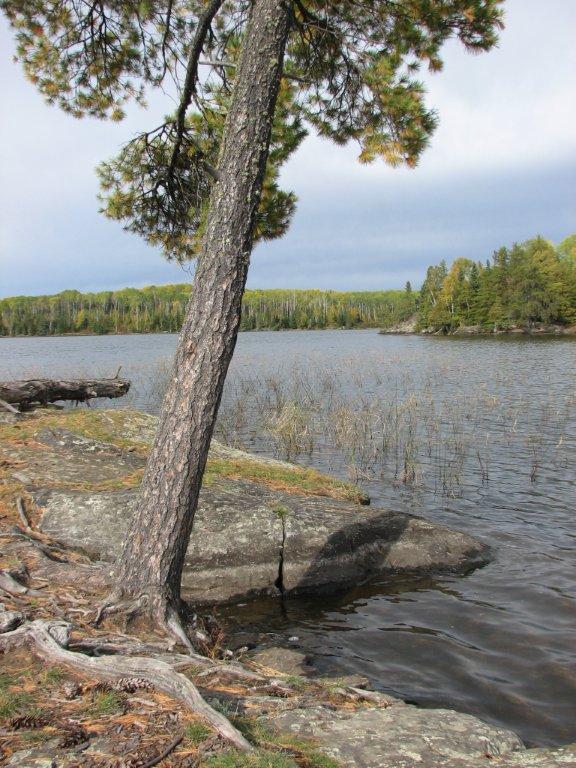Take action!
Background
Northern Minnesota is one of the world’s most water-rich environments. Studies indicate that sulfide mining always impacts nearby waters in such an environment. The headwaters of two internationally important water resources (Lake Superior and the Boundary Waters Canoe Area) is the worst possible place to locate sulfide mines.
What is sulfide mining? Sulfide ores contain heavy metals (such as copper or nickel) that are bonded to sulfur, forming sulfide minerals. When exposed to air and moisture, a chemical reaction generates sulfuric acid that can leach into the surrounding environment and cause the release of the metals into streams and lakes at levels that are toxic to fish and other aquatic life. This phenomenon is known as Acid Mine Drainage or AMD.
Acid Mine Drainage (AMD) - Boundary Waters Canoe Area


The First Three Mines
Three large copper-nickel sulfide projects are in the development stage. These potential mines are located in the Babbitt-Ely area, to the east of the current taconite mines and within the boundaries of the Superior National Forest. If all the mines are permitted, they will extend in a line almost 50 miles long, beginning at the BWCAW boundary south of Ely.
PolyMet Mining Company’s NorthMet Mine
The project that is farthest along is PolyMet Mining Company’s NorthMet Mine, which is currently undergoing environmental review. A Draft Environmental Impact Statement (DEIS) was released in October 2009, but was given an unsatisfactory rating by the U.S. EPA, which has oversight authority over the Minnesota Pollution Control Agency and Army Corps of Engineers implementation of the Clean Water Act. PolyMet and the regulatory agencies now say that a Supplemental DEIS will be released for public review in the second quarter of 2012.
The Twin Metals Projects
Twin Metals is a joint venture targeting what were originally four separate ore bodies: the Nokomis, Birch Lake, Maturi, and Spruce Road deposits. The companies involved in this venture include Duluth Metals, Antofagasta, and Franconia.
Teck Cominco’s Mesaba Project
The third of the “first three” is Teck Cominco’s Mesaba Project, located between the NorthMet project to the south and the Twin Metals projects to the north. This mine would be located in the headwaters of the Partridge River, which will already be heavily impacted by the NorthMet Mine if it is permitted. Teck Cominco did extensive bulk sampling in 2008-09, and has since been working on process development.
Is Northern Minnesota a good location for sulfide mining?
In the scramble for money that new mines represent to the mining industry and many of our elected officials, truth has been the first casualty. The reality of human nature is that when people see the opportunity for profit, they believe what they need to believe, regardless of the countervailing evidence. What this means to Northern Minnesota is that regulatory agencies are being pushed to permit new mines despite indications that the mines will not operate without polluting lakes, rivers, streams and groundwater.
To hear mining companies and elected officials tell it, any new copper-nickel sulfide mine that is permitted in Minnesota will operate “cleanly,” without polluting nearby waters. But the track record of sulfide mines in other locations indicates that the mining industry does not yet have the ability to keep sulfuric acid and heavy metals from leaching into the environment. Mining operations typically excavate hundreds of millions of tons of sulfur bearing rock, much of which is left at mine sites as waste. Segregating this rock from the surrounding environment has proven impossible for the mining industry as a practical matter.
Permitting mines that will require perpetual treatment of wastewater is the worst example of obtaining the benefit of using natural resources today while passing the costs on to future generations. Human history provides no basis to believe that our current government or social systems will continue for the length of time that treatment will be required, with estimates extending to 10,000 years. At least two states (New Mexico and Michigan) do not permit mines that will require perpetual treatment; the Minnesota DNR appears poised to allow it at the proposed NorthMet Mine.
Ways you can help save Minnesota's beloved Arrowhead:
Become Informed
· Understanding the issues is an important part of knowing what we can do to stop the destruction of Minnesota's Arrowhead.
Communicate Broadly
· Communicate your opposition to sulfide mining with your elected representatives, including local, state and federal officials.
· Write letters to the editor of local, state and national newspapers and other publications, participate online.
· Listen to local talk radio and call in when issues relating to the environment are featured.
· Attend hearings, and speak up against sulfide mining, take a firm stand to insist on a "prove it first" moratorium on sulfide mining.
· Follow the projects through the environmental review process, submit comments, attend public meetings.
· Engage in conversation with your friends and neighbors to help them understand the dangers that sulfide mining poses to our area.
Who to contact? Copper-nickel sulfide mining media and legislative targets can be found Here
Support "Prove-it-First" Legislation similar to Wisconsin's Mining Moratorium Law : Act 171
1997 Act 171: Mining Moratorium Law
In April 1998, then-Governor Tommy Thompson signed 1997 Wisconsin Act 171 into law. This law amended the metallic mining statute to establish an additional provision that an applicant for a metallic mining permit must meet in order to receive a mining permit. Commonly referred to as the "Mining Moratorium Law" (s. 293.50, Wisconsin Statutes), the law requires an applicant to provide examples of a mining operation in the U.S. or Canada that have not resulted in significant environmental pollution. The law includes specific qualifying criteria that must be satisfied in order for the example site, or sites, to be considered. The mining company must submit documentation from groundwater/surface water monitoring that includes data showing that:
(1) An example mine has been closed for 10 years without the pollution of groundwater or surface water from acid drainage at the tailings site or at the mine site or from the release of heavy metals; and
(2) An example mine has operated for 10 years without the pollution of groundwater or surface water from acid drainage at the tailings site or at the mine site or from the release of heavy metals.
In addition, the candidate mine or mines identified must be located in a sulfide ore body that together with the host rock has a net acid generation potential (i.e. the potential to create acid drainage). Furthermore, the candidate mine cannot be listed on the national priorities list of contaminated sites, and cannot be an operation for which the operator is no longer in business and has no successor that may be liable for contamination.
The Department must verify the information and present its recommendations on satisfying the requirements of the Mining Moratorium Law before a mining permit can be issued.
Statutory Language
Because the wording of any law determines how the Department interprets the law, we have reproduced the Mining Moratorium Law in its entirety, as adopted by the Legislature.
293.50 Moratorium on issuance of permits for mining of sulfide ore bodies. (1) In this section:(a) "Pollution" means degradation that results in any violation of any environmental law as determined by an administrative proceeding, civil action, criminal action or other legal proceeding. For the purpose of this paragraph, issuance of an order or acceptance of an agreement requiring corrective action or a stipulated fine, forfeiture or other penalty is considered a determination of a violation, regardless of whether there is a finding or admission of liability. (b) "Sulfide ore body" means a mineral deposit in which metals are mixed with sulfide minerals. (a) The department determines, based on information provided by an applicant for a permit under s. 293.49 and verified by the department, that a mining operation has operated in a sulfide ore body which, together with the host rock, has a net acid generating potential in the United States or Canada for at least 10 years without the pollution of groundwater or surface water from acid drainage at the tailings site or at the mine site or from the release of heavy metals. (b) The department determines, based on information provided by an applicant for a permit under s. 293.49 and verified by the department, that a mining operation that operated in a sulfide ore body which, together with the host rock, has a net acid generating potential in the United States or Canada has been closed for at least 10 years without the pollution of groundwater or surface water from acid drainage at the tailings site or at the mine site or from the release of heavy metals. (2m) (a) The department may not base its determination under sub. (2) (a) or (b) on any mining operation that has been listed on the national priorities list under 42 USC 9605 (a) (8) (B) or any mining operation for which the operator is no longer in business and has no successor that may be liable for any contamination from the mining operation and for which there are no other persons that may be liable for any contamination from the mining operation. (b) The department may not base its determination under sub. (2) (a) or (b) on a mining operation unless the department determines, based on relevant data from groundwater or surface water monitoring, that the mining operation has not caused significant environmental pollution, as defined in s. 293.01 (4), from acid drainage at the tailings site or at the mine site or from the release of heavy metals. (3) This section applies without regard to the date of submission of the permit application. History: 1997 a. 171 |


